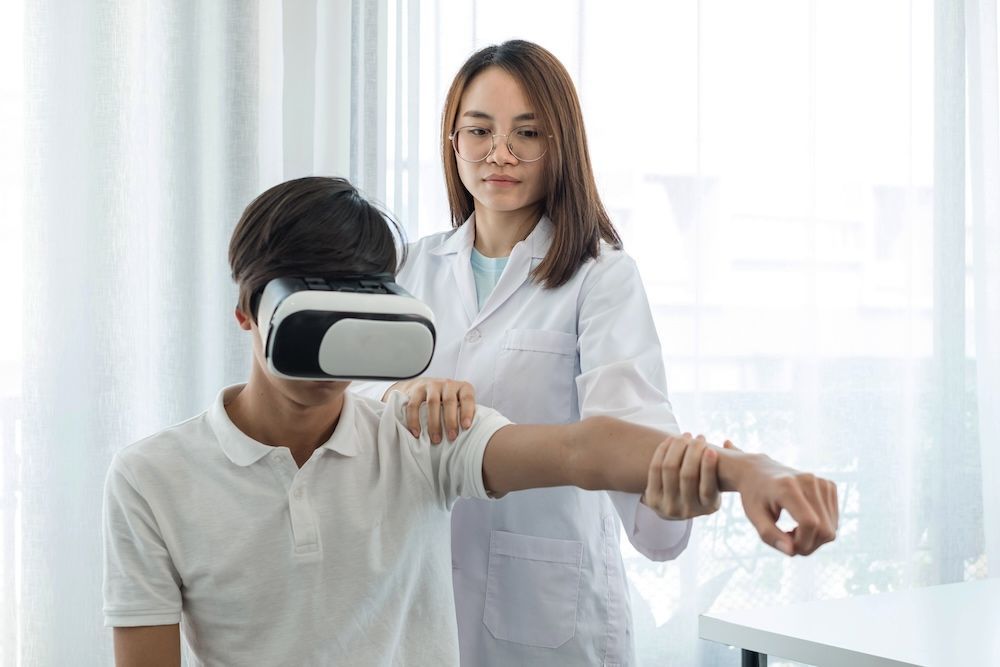As with many healthcare professions, being able to practice physical therapy cases prior to entering the field can provide valuable experience to future physical therapists. DxR Development Group’s VirtualPT Clinician software mirrors the clinical reasoning process used by physical therapists. This clinical simulation is designed to teach, and evaluate key critical-thinking skills solutions. VirtualPT Clinician delivers proven, problem-based education and virtual patient experiences in the classroom, remotely, individually, or in group learning.
Educators can use VirtualPT Clinician to challenge their learners to apply the knowledge they gain in the classroom. VirtualPT Clinician cases require learners to assess and diagnose a ‘virtual’ patient’s problems, establish goals, and develop a management plan. Also, VirtualPT Clinician provides an easy-to-use framework to collect patient history information from an extensive bank of patient interview questions. Learners are able to form a problem list and a list of associated working hypotheses based on the patient data they collect.
VirtualPT Clinician allows learners to conduct ‘virtual’ physical exam procedures, including specialized measures used in physical therapy practice. They may view videos of patient movement and listen to real heart and lung sounds to make clinically significant observations. Further, learners can order diagnostic tests to support clinical decision-making, develop a list of final diagnoses, establish patient goals, and develop a list of interventions. Lastly, learners can review immediate feedback on their performance.
VirtualPT Clinician is delivered through a robust, flexible software framework that tracks student decisions. Faculty can use the cases as written by the case author or can modify them to meet specific teaching goals and the educational levels of their learners. The resulting records include data for a comprehensive evaluation of student performance and a clearer picture of students’ ability to apply knowledge to clinical problems.
Instructors evaluate, score, and report learner performance in the Record Utility. In addition to faculty being able to gain insights into individual learners’ problem-solving process as they worked through the case study, instructors can evaluate learners’ prognoses and review how students associated interventions and functional goals with patient problems. Group scoring data reveal areas in which your group needs additional instruction and practice as well.
Note: The VirtualPT Case Authoring tool allows instructors to create a new patient case, with their own evaluation criteria, and then post the case for students to use immediately.
Virtual Patient Cases: Improving Physical Therapy Education
In this blog post, DxR Project Manager Jeanne Ferraro and Communications Director Beth Hart recently spoke with Dr. Karen Huhn, the guiding academic force behind VirtualPT Clinician. Dr. Huhn discussed teaching physical therapy in the new environment, and how VirtualPT Clinician can help faculty improve learners develop as clinicians.
Here is an excerpt from their conversation discussing how can virtual patient cases help PT faculty teach online:
Question: How do you think resources like VirtualPT Clinician have played into how you have been able to adapt?
Dr. Karen Huhn: I think it’s fabulous because it is a great way, during a pandemic or not, to expose students to a wide variety of patient cases and have them think through the cases. Our being able to see, sort of visualizing the student’s thought processes because of the way the program tracks what the students do in the program. And students being able to do that no matter where they are, as long as they have internet access.
They could do it anywhere and any time. So it is easy to work around when we are doing synchronous lectures online, students can be doing these cases at any time, and then we can see what they did and still give them feedback, again, on our own time, whenever we get to it. So there is a lot of flexibility in using it. But, I think, it’s obviously best at the Clinical Reasoning process but it is also very good for exposing students to a wide variety of patient cases, types, and kinds of patient cases.
Question: …and a consistent experience across the class…
Dr. Karen Huhn: Right, I can expose all my students to the same case and know they have all experienced that same diagnosis, that same patient interaction, the same cultural aspects of the case, quite easily.
More About DxR Development Group
DxR Development Group, Inc. was founded in 1992 by Professor Hurley Myers and Dr. Kevin Dorsey of the Southern Illinois University Medical School, and software engineer Eldon Benz. The company was formed and launched the Diagnostic Reasoning product on a floppy disk. Later named DxR Clinician, the program allowed medical learners to interact with a “virtual” patient. Learners gathered clinical data through interview questions, conducting a virtual physical exam, and selecting lab tests from a database, and interpreting patient results, all aimed at arriving at the correct medical diagnosis, supported by the patient data. The idea was a new one that caught on quickly with medical schools that were early adopters of technology in the classroom
While the company’s roots are in medical education software, DxR quickly expanded to develop applications for pharmaceutical companies, non-profit organizations, and other healthcare-related organizations. More recently, the company has moved into online testing and training, website design and development, and business application development.
Today, DxR Development Group virtual patient software is used around the globe, particularly in Asia. Company partners — Chun Shin Limited and DxR Asia-Pacific — distribute DxR Clinician, DxR Nursing SELECT, Clinical Competency Exam, and VirtualPT Clinician in both English and Chinese. DxR Clinician is also available in Japanese.
DxR Development Group’s staff stands ready to assist educational innovators, businesses, and non-profit groups with their educational, web application, and technology needs. The company remains committed to a thoughtful, sound, and customer-centered development process.








